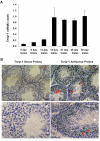0610009K11Rik, a testis-specific and germ cell nuclear receptor-interacting protein
- PMID: 18082624
- PMCID: PMC2254506
- DOI: 10.1016/j.bbrc.2007.12.035
0610009K11Rik, a testis-specific and germ cell nuclear receptor-interacting protein
Abstract
Using an in silico approach, a putative nuclear receptor-interacting protein 0610009K11Rik was identified in mouse testis. We named this gene testis-specific nuclear receptor-interacting protein-1 (Tnrip-1). Tnrip-1 was predominantly expressed in the testis of adult mouse tissues. Expression of Tnrip-1 in the testis was regulated during postnatal development, with robust expression in 14-day-old or older testes. In situ hybridization analyses showed that Tnrip-1 is highly expressed in pachytene spermatocytes and spermatids. Consistent with its mRNA expression, Tnrip-1 protein was detected in adult mouse testes. Immunohistochemical studies showed that Tnrip-1 is a nuclear protein and mainly expressed in pachytene spermatocytes and round spermatids. Moreover, co-immunoprecipitation analyses showed that endogenous Tnrip-1 protein can interact with germ cell nuclear receptor (GCNF) in adult mouse testes. Our results suggest that Tnrip-1 is a testis-specific and GCNF-interacting protein which may be involved in the modulation of GCNF-mediated gene transcription in spermatogenic cells within the testis.
Figures




Similar articles
-
The murine nuclear orphan receptor GCNF is expressed in the XY body of primary spermatocytes.FEBS Lett. 1998 Nov 20;439(3):208-14. doi: 10.1016/s0014-5793(98)01327-1. FEBS Lett. 1998. PMID: 9845324
-
Characterization of germ cell-specific expression of the orphan nuclear receptor, germ cell nuclear factor.Endocrinology. 1997 Oct;138(10):4364-72. doi: 10.1210/endo.138.10.5444. Endocrinology. 1997. PMID: 9322952
-
Analysis of germ cell nuclear factor transcripts and protein expression during spermatogenesis.Biol Reprod. 2003 May;68(5):1620-30. doi: 10.1095/biolreprod.102.012013. Epub 2002 Dec 11. Biol Reprod. 2003. PMID: 12606326
-
Expression of germ cell nuclear factor (GCNF/RTR) during spermatogenesis.Mol Reprod Dev. 1998 May;50(1):93-102. doi: 10.1002/(SICI)1098-2795(199805)50:1<93::AID-MRD12>3.0.CO;2-Z. Mol Reprod Dev. 1998. PMID: 9547515
-
Germ cell nuclear factor is a transcriptional repressor essential for embryonic development.Front Biosci. 2001 Oct 1;6:D1186-91. doi: 10.2741/hummelke. Front Biosci. 2001. PMID: 11578963 Review.
Cited by
-
Expression of zinc finger protein 105 in the testis and its role in male fertility.Mol Reprod Dev. 2010 Jun;77(6):511-20. doi: 10.1002/mrd.21171. Mol Reprod Dev. 2010. PMID: 20186958 Free PMC article.
-
Androgen-induced Rhox homeobox genes modulate the expression of AR-regulated genes.Mol Endocrinol. 2010 Jan;24(1):60-75. doi: 10.1210/me.2009-0303. Epub 2009 Nov 9. Mol Endocrinol. 2010. PMID: 19901196 Free PMC article.
-
Mutation of Eif4g3, encoding a eukaryotic translation initiation factor, causes male infertility and meiotic arrest of mouse spermatocytes.Development. 2010 May;137(10):1699-707. doi: 10.1242/dev.043125. Development. 2010. PMID: 20430745 Free PMC article.
References
-
- Setchell BP. Spermatogenesis and Spermatozoa. In: Austin CR, Short RV, editors. Reproduction in Mammals: Germ Cells and Fertilization. Cambridge University Press; 1993. pp. 63–101.
-
- Chen F, Cooney AJ, Wang Y, Law SW, O’Malley BW. Cloning of a novel orphan receptor (GCNF) expressed during germ cell development. Mol.Endocrinol. 1994;8:1434–44. - PubMed
-
- Hirose T, O’Brien DA, Jetten AM. RTR: a new member of the nuclear receptor superfamily that is highly expressed in murine testis. Gene. 1995;152:247–51. - PubMed
Publication types
MeSH terms
Substances
Grants and funding
LinkOut - more resources
Full Text Sources
Molecular Biology Databases
Research Materials

